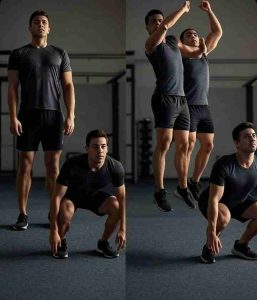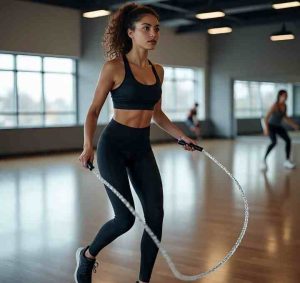The Science Behind Jumping and Bone Growth
 Bones are living tissues that respond to mechanical stress by becoming stronger and denser. This process, known as bone remodeling, involves the activity of osteoblasts (cells that build bone) and osteoclasts (cells that break down bone). High-impact exercises like jumping create micro-stresses in the bones, signaling the body to deposit more mineral content, thus enhancing bone density.
Bones are living tissues that respond to mechanical stress by becoming stronger and denser. This process, known as bone remodeling, involves the activity of osteoblasts (cells that build bone) and osteoclasts (cells that break down bone). High-impact exercises like jumping create micro-stresses in the bones, signaling the body to deposit more mineral content, thus enhancing bone density. Benefits of Jumping Exercises for Bone Health
- Increased Bone Density: Jumping places controlled stress on bones, encouraging the body to strengthen them over time.
- Improved Joint Stability: Regular jumping strengthens the muscles and ligaments around joints, supporting skeletal health.
- Enhanced Coordination and Balance: Jumping exercises improve proprioception, reducing the risk of falls and fractures.
- Cardiovascular Benefits: Many jumping exercises double as cardio workouts, improving heart health and endurance.
- Accessibility: Most jumping exercises require minimal equipment and can be done at home, in a gym, or outdoors.
- Mental Health Boost: The dynamic nature of jumping can release endorphins, improving mood and reducing stress.
Top Jumping Exercises to Promote Bone Growth
Below is a curated list of jumping exercises that are effective for promoting bone health. Each exercise is described with instructions, benefits, and tips for beginners to ensure safety and effectiveness. Always consult a healthcare professional before starting a new exercise regimen, especially if you have pre-existing health conditions.
1. Jump Squats
How to Perform:
- Stand with feet shoulder-width apart.
- Lower into a squat, keeping your knees behind your toes and your chest upright.
- Explosively jump upward, extending your legs fully.
- Land softly back into the squat position and repeat.
- Aim for 3 sets of 10–15 reps.

The image shows jump squats from the first step to the last step which involves standing, squatting, jumping from the squatting position and landing directly on the squatting position.
Benefits: Jump squats target the lower body, particularly the femur and hip bones, while also engaging the core and improving explosive power. Beginner Tip: Start with bodyweight squats to build strength before adding the jump. Use a soft surface like a mat to reduce impact.
2. Box Jumps
 How to Perform:
How to Perform:
- Stand in front of a sturdy box or platform (12–24 inches high, depending on your fitness level).
- Bend your knees slightly, swing your arms, and jump onto the box, landing with both feet.
- Step down carefully and repeat.
- Perform 3 sets of 8–12 reps.
Benefits: Box jumps are excellent for building bone density in the legs and hips while improving coordination and power.
Beginner Tip: Start with a low box and focus on landing softly to minimize joint stress.
3. Single-Leg Hops
 How to Perform:
How to Perform:
- Stand on one leg with a slight bend in the knee.
- Hop forward, landing on the same leg, and stabilize yourself before hopping again.
- Switch legs after 10–12 hops and repeat for 2–3 sets per leg.
Benefits: Single-leg hops strengthen the bones in the ankles, shins, and knees while improving balance and unilateral strength.
Beginner Tip: Hold onto a wall or chair for support until you build confidence in your balance.
4. Skipping Rope
 How to Perform:
How to Perform:
- Hold a jump rope with both hands, keeping elbows close to your body.
- Swing the rope and jump lightly over it with both feet, landing on the balls of your feet.
- Continue for 30–60 seconds, rest, and repeat for 3–5 sets.
Benefits: Jumping rope is a high-impact, low-cost exercise that stimulates bone growth in the legs and improves cardiovascular fitness.
Beginner Tip: Start with short intervals (10–20 seconds) and gradually increase duration as your endurance improves.
5. Tuck Jumps
How to Perform:
- Stand with feet hip-width apart.
- Jump upward, tucking your knees toward your chest at the peak of the jump.
- Land softly and immediately prepare for the next jump.
- Perform 3 sets of 8–10 reps.
Benefits: Tuck jumps are intense, targeting the hip and leg bones while boosting explosive strength and core stability.
Beginner Tip: Focus on small jumps initially and prioritize landing softly to protect your joints.
6. Lateral Jumps
How to Perform:
- Stand with feet together and imagine a line on the ground.
- Jump sideways over the line, landing on both feet, then jump back to the starting position.
- Continue for 10–12 jumps per side for 2–3 sets.
Benefits: Lateral jumps improve bone density in the hips and legs while enhancing lateral movement and agility.
Beginner Tip: Start with small jumps and focus on maintaining balance during landings.
Tips for Safe and Effective Jumping Exercises
- Warm Up Properly: Begin with 5–10 minutes of dynamic stretching or light cardio to prepare your muscles and joints.
- Use Proper Footwear: Wear supportive athletic shoes with good cushioning to reduce impact on your joints.
- Start Slowly: If you’re new to jumping exercises, begin with low-impact variations and gradually increase intensity.
- Focus on Form: Proper landing technique (soft knees, landing on the balls of your feet) is crucial to prevent injury.
- Choose Rest Days: High-impact exercises stress the bones, so allow at least 1–2 rest days between sessions to promote recovery.
- Combine with Strength Training: Pair jumping exercises with resistance training to maximize bone health benefits.
- Stay Hydrated and Eat Well: A diet rich in calcium, vitamin D, and protein supports bone remodeling and overall health.
Who Can Benefit from Jumping Exercises?
Jumping exercises are suitable for a wide range of individuals, including:
- Adolescents and Young Adults: To build peak bone mass during developmental years.
- Adults: To maintain bone density and prevent age-related bone loss.
- Athletes: To improve performance and skeletal strength for sports.
- Older Adults: To support bone health and reduce fracture risk (with modifications and medical clearance).
However, individuals with joint issues, osteoporosis, or other medical conditions should consult a doctor or physical therapist before starting high-impact exercises.
How Often Should You Do Jumping Exercises?
For optimal bone health, aim to perform jumping exercises 2–3 times per week, allowing rest days in between to prevent overuse injuries. A balanced routine might include 20–30 minutes of jumping exercises combined with strength training and flexibility work. Beginners should start with shorter sessions (10–15 minutes) and gradually increase duration and intensity as their fitness improves.
SEE ALSO:
Boost Your Brainpower: Engaging Critical Thinking Exercises for All Ages
Why Does Weight Training Improve Muscular Strength More Than Cardiorespiratory Fitness?
Conclusion
Jumping exercises are a fun, effective, and accessible way to promote bone growth and maintain skeletal health. By performing exercises like jump squats, box jumps, and skipping rope, you can strengthen your bones, improve coordination, and boost overall fitness. Remember to prioritize safety by starting slowly, using proper form, and consulting a healthcare professional if needed. With consistency and care, jumping exercises can be a powerful tool in your journey towards stronger and healthier bones.